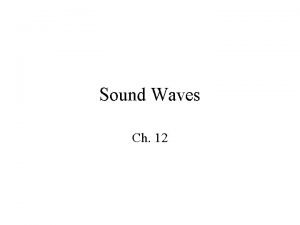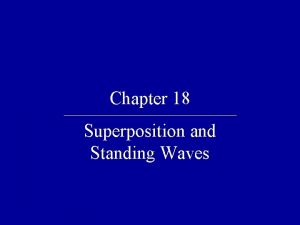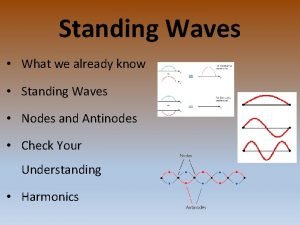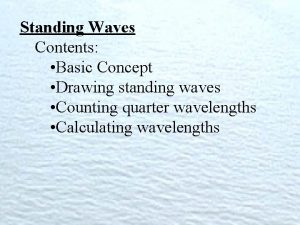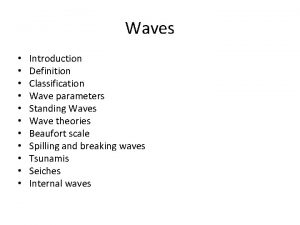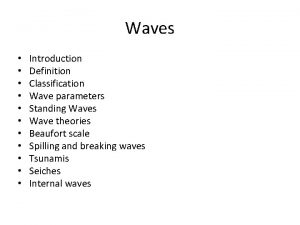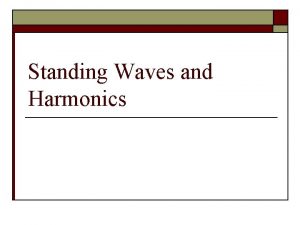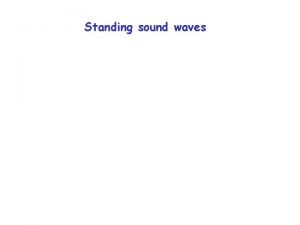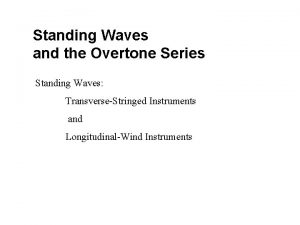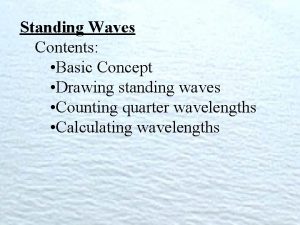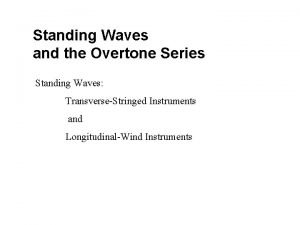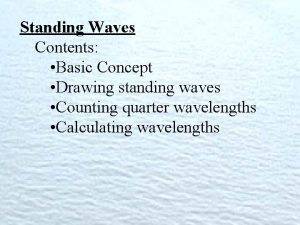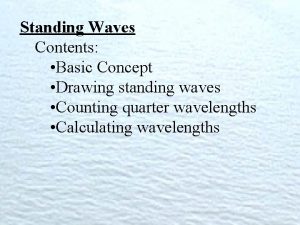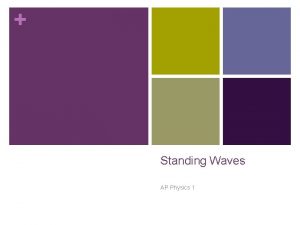Standing Waves Definition A Standing WaveStationary wave is



















- Slides: 19

Standing Waves

Definition • A Standing Wave/Stationary wave is the resultant wave of two waves of the same amplitude, wavelength, frequency (thus also velocity) traveling in opposite directions through the same medium. • The resultant wave appears to be standing still (neither moving left of right)

Superposition/Interference • Standing waves are the result of superposition of 2 (or more) waves • Applet

Parts of a Standing wave • Node: Parts of a standing wave where the medium has no/minimum amplitude • Antinode: Parts of a standing wave with the maximum amplitude

Node: Antinode: How many Nodes & Antinodes 3 2 5 4 Node: Antinode: 3 4 Node: Antinode: 4 3

Other types of standing waves

Instruments Use Standing Waves • The note played by an instrument is related to a standing wave produced in the instrument • String for guitars, pianos, violins…. • The standing wave/pitch can be adjusted by; • Density of string • Tension in string • Length of string • Air for trumpets, saxophone, flute…. • The standing wave/pitch can be adjusted by; • Length of tube • Open vs. closed end of tube • Adjusting source frequency (buzzing of lips)

String standing wave •

String standing wave •

Tube Standing Waves • The medium of air is a longitudinal wave

Tube Standing Waves • The medium of air is a longitudinal wave • Helps to view it as a transverse wave

Tube Standing Waves • 3 options 1) Both ends open • • Both ends are antinodes Always one more antinode than node 2) One end open, one end closed • • One end node, other antinode Equal number of nodes/antinodes 3) Both ends closed • • • Both ends are nodes Always one more node than antinode Applet

Standing Wave Equation •

Standing Wave Equation •

Standing Wave Equation •

Standing Wave Equation • Example 1 a) Original organs were a series of different length pipes. If the largest pipe is 2. 675 m long and is closed on one end and open on the other, what is the largest (fundamental) wave it can produce? b) If the speed of sound is ~343 m/s, what is the frequency of the wave?

Standing Wave Equation • Example 2 A pipe for an organ needs to produce a note of middle C (262 Hz). What length of tube is needed if; a) b) The tube is open on one side and closed on the other The tube is open on both sides


Standing wave Disaster • Tacoma Narrows Bridge Collapse
 Difference between standing crop and standing state
Difference between standing crop and standing state Wavelength constructive interference
Wavelength constructive interference Sonic spectrum definition
Sonic spectrum definition Standing waves quiz
Standing waves quiz Standing waves
Standing waves Nodes and antinodes
Nodes and antinodes Draw a picture of standing waves with n=3
Draw a picture of standing waves with n=3 Mechanical waves examples
Mechanical waves examples Longitudinal vs transverse wave
Longitudinal vs transverse wave Similarities of mechanical and electromagnetic waves
Similarities of mechanical and electromagnetic waves Differences between mechanical and electromagnetic waves
Differences between mechanical and electromagnetic waves Characteristics of a longitudinal wave
Characteristics of a longitudinal wave Whats a reflected sound wave
Whats a reflected sound wave Short wave vs long wave radiation
Short wave vs long wave radiation Difference between matter waves and electromagnetic waves
Difference between matter waves and electromagnetic waves Examples of mechanical and electromagnetic waves
Examples of mechanical and electromagnetic waves Mechanical waves and electromagnetic waves similarities
Mechanical waves and electromagnetic waves similarities Surface waves and body waves
Surface waves and body waves Seismic waves are mechanical waves
Seismic waves are mechanical waves Compare and contrast p waves and s waves using venn diagram
Compare and contrast p waves and s waves using venn diagram


